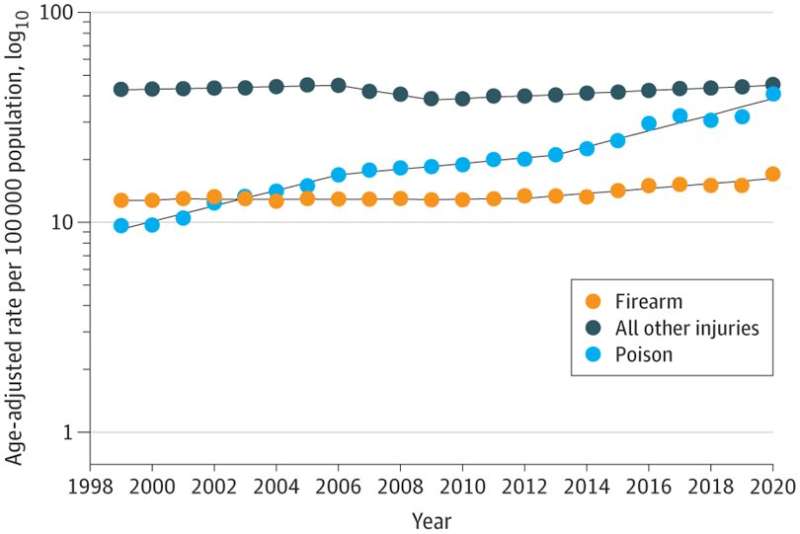A team of researchers from several institutions led by the National Institutes of Health has examined U.S. national death trends. In a paper, "Trends in Mortality From Poisonings, Firearms, and All Other Injuries by Intent in the US, 1999-2020," published in JAMA Internal Medicine, the researchers find disturbing trends in the rate and manner in which Americans are dying.
The study finds the number of deaths due to external causes per 100,000 population increased from 65.6 in 1999 to 103.5 in 2020, with poisonings making up most of the difference at +31.18, followed by firearms at +4.18.
Between 1999 and 2020, death rates from poisoning increased annually at an average rate of 7%. This alarming increase was likely due to the opioid prescription crisis, followed by the secondary street drug market for those addicted to opioids as the prescription market tightened. Death rates due to poisoning more than tripled between 1999 to 2020, nearly overtaking all other injuries as the leading external cause of death.
Since 2008, poisoning death rates from suicide have decreased annually, which may not reflect an uptick in good mental health so much as easier access to more lethal means, such as firearms, or a masking of suicide data amid the opioid prescription epidemic.
From 1999 to 2020, firearm death rates increased by 1.1%. Narrowing the view to 2014 to 2020 homicides shows that homicides with guns increased by an average of 6.9% annually.
African Americans had the highest rates of firearm deaths throughout the study period, several times higher than those of Asian and Pacific Islanders, who had the lowest (24.5 vs. 3.3 per 100,000 population, respectively). Native American and Alaska Native individuals experienced the most rapid increase in annual firearm death rates at 3%.
From 2019 to 2020, death rates from poisonings, firearms, and all other injuries increased, with the largest increases again observed for poisoning deaths (8.92 per 100,000 population). A 28% increase from 2019 to 2020 in the poisoning death rate was three times greater than the average annual increase from 2013 to 2020[.]
Sorting the data by intent, the largest relative increases in death rates were intentional firearm-involved homicides and unintentional poisonings.
The study findings highlight the need for multilevel public health interventions to counteract the increasing national trends in mortality due to external causes. The authors state that the rapid increase in deaths due to unintentional poisonings and firearm homicides is a national emergency that requires urgent attention at the local and national levels.
- alf9872000
-

 1
1



Recommended Comments
There are no comments to display.
Join the conversation
You can post now and register later. If you have an account, sign in now to post with your account.
Note: Your post will require moderator approval before it will be visible.